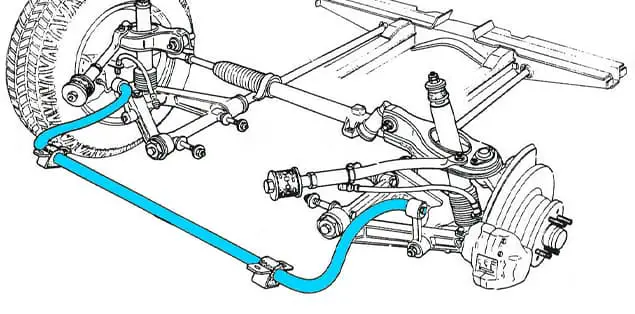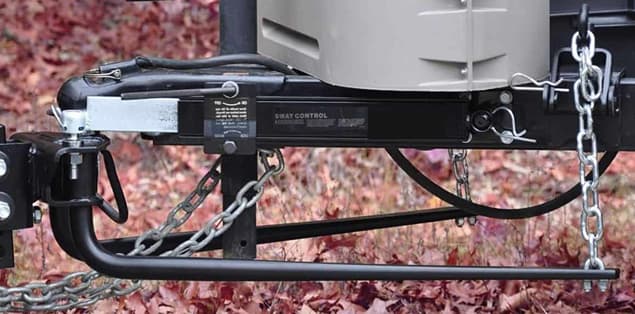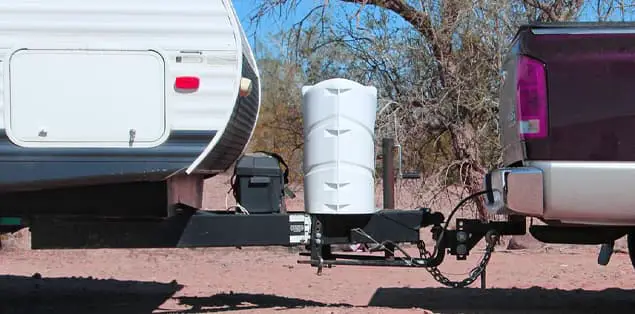So, do you need sway bars for a small camper? One thing that causes the most anxiety to new RVers is sway. Sway may create plenty of problems for RVers, so controlling it is critical. Sway control device is available for RVs to help ensure a safe trip for everyone. Sway bars are an option for RVers, but do you need them?
Does my travel trailer require sway bars for a small camper to stabilize it? It is a common concern for new RV owners, so you’re not alone. Installing this RV suspension add-on is a popular choice among experienced rovers.
For the time being, let’s concentrate on the subject. We hope this article gives you a better grasp of the necessity of having a sway bar installed in your travel trailer.
Do You Need a Sway Bar to Drive?

If you ask, “Do I need a sway bar for my trailer?” the answer is yes. Sway bars work. If you are afraid it is just an unnecessary expense, you shouldn’t be since it will be one of the most significant investments you’ll ever make.
What is Sway?
Before we dive deep into the topic, let’s answer the question you’re thinking.
Consider the following scenario. It has been months of preparing, and you are finally on your way to the camping vacation you’ve been looking forward to for so long. Your trailer suddenly sways from side to side as a mighty wind blows across the area.
Because of your counter-steering, the swaying only gets worse. As a result, your trailer began to sway violently from side to side, and your truck and trailer slid off the road. Many things could go wrong while hauling a trailer, but this is one of the most frightening.
Trailer sway is a primary cause of trailer-related accidents and a significant factor in the decision of many camper trailer owners to give up after just one season of using their vehicle. Having your trailer shake while driving along a highway is a terrifying experience that many people fear.
It is one of the scariest things that trailer drivers might encounter, but fortunately, a valuable tool can prevent sway. A variety of factors cause the swaying of a trailer. Improper weight distribution, gusts of wind, and driving at an excessive speed are the primary contributors to sway. Typically, this occurs when the trailer moves from side to side behind the tow vehicle due to pressure applied to its sides.
“Fishtailing” is another name for it. Although the wind is the most common cause of trailer sway, it is not the only one to be aware of. Therefore, trailer sway bars are a must-have if you want a safe camping trip.
What Is a Sway Bar?
To prevent your car from rolling over, you may employ sway bars, often referred to as stabilizer bars. It is a steel bar shaped like a U attached to the vehicle and runs between the wheels of the front of the vehicle. Whenever you make a turn in a car, the body naturally leans to one side. Your car is said to be experiencing “body roll” or “sway” when this happens. A sway bar will evenly distribute body roll, and your vehicle will remain more level and under control.
It’s also important to remember that your automobile will swing and roll as you go around a bend. It causes the suspension on your car’s outside wheels to compress as more of the vehicle’s weight is moved to the wheels closer to the vehicle’s edges. Just consider: while making a quick turn, you can feel your body shifting or drifting to the outside of the curve.
Think about how your body sways as you drive around a bend and imagine your car doing the same thing. Tension control sway bars are installed in vehicles to minimize body roll.
When Should You Use Sway Bars on a Trailer?

Always is the quick and sweet answer. However, it’s important to remember that a sway solid bar isn’t necessary. However, if you’re looking for a more reliable and pleasant towing experience, it’s worth the investment.
Towing a compact trailer with the factory sway bars is an option in some cases. However, if you plan on towing a tall travel trailer, you might consider upgrading your vehicle’s sway bar.
A trailer sway bar connects directly to the tongue of a trailer to the tow hitch and acts as an extra connecting point, reducing and dampening the sway of the trailer.
But there’s much more to know about sway bars for trailers than their fundamental function. So when it comes to trailer sway bars, you can learn more about their role and how they operate by reading this article further.
Travel trailer sway bars may be optional, but we believe they are essential for a safe and easy towing experience; thus, we recommend installing them. A vehicle sway bar upgrade for truck campers or motorhomes is a must-have.
Because sway bar hitches provide a more solid attachment point between the tow vehicle and the travel trailer, they perform an excellent job of damping and eliminating unexpected swings in the trailer.
You can make towing considerably safer and more controllable no matter how intense the outside forces are, such as severe winds or crosswinds from passing cars.
What Is the Purpose of Sway Bars on a Camper?

Sway bars minimize camper sway when driving down the highway, and they may even save your life if your vehicle is in danger of rolling over. Although some drivers complain that sway bars make it more difficult to turn, the added security they provide is well worth the cost.
Sway bars are standard on most campers on the market nowadays, so you don’t have to go out and buy one if you don’t want to. RVs must include sway bars as a safety feature.
If you don’t have sway bars pre-installed on your camper or are still debating whether or not to get one, the information provided in the following paragraphs will help you make an informed decision.
There are essentials when purchasing an RV, and then there are add-ons. Add-ons and additional features for your unit might quickly turn into a never-ending cycle of spending money. Because there are so many RV-related items on the market, it may be challenging to determine which ones are most relevant.
The sway bars on your car aren’t a waste of money. But, in reality, it’s the complete opposite! You, your passengers, and your RV might benefit from this robust metal structure.
Outside influences and stress are common among campers. They are susceptible to wobbling while traveling at fast speeds. The trailer and tow vehicle might collide and turn over if the driver cannot control the movement. It is a hazardous circumstance that might lead to death. Many variables might cause you to wobble while driving.
Wind
A variety of factors can cause a trailer to sway. Travel trailers are typically bigger than vehicles and have a remarkable flat surface space. If the wind strikes it directly in the face, it will be difficult to resist. Therefore, a sway bar for your camper is a must if you want to avoid being buffeted by high winds while traveling at highway speeds.
Uneven roads
If you prefer off-grid camping, you will likely encounter quite tricky roads. The majority of vehicles can manage these circumstances, particularly trailer-pulling trucks. However, the majority of travel trailers lack the same robust suspension.
During harsh conditions, they may become imbalanced and begin to twist or slide toward the towing vehicle. A sway bar is essential in these situations! As a result, the trailer is kept in position and does not move out of place.
Sharp Turns
When making a tight turn, the same thing occurs. Travel trailers are tricky to maneuver, and driving maneuvers may be complex. When highway speeds, the centrifugal force might put undue strain on the camper. Because they’re so massive and top-heavy, they’re prone to tipping over. Large vehicles, such as semi-trucks, face the same dangers.
Careful driving is the recommended course of action in this case. Allow yourself plenty of time to complete the turn and do it slowly. People behind you may be a little irritated by your decision, but it’s worth it in the long run since you’re making everyone safer.
Passing Automobiles
While driving on a highway, you’ve undoubtedly experienced the sensation of being a little shaken up by a semi-truck. As a result, you get sucked into the slipstream of other cars. Vehicle and camper swaying are possible due to the high wind speed and pressure. Sway bars reduce this movement and speed up your recovery time if you get unsteady.
Weight Distribution
Sway bars assist in evenly distributing the weight of campers and the vehicles that pull them. Thus, many current sway bars come with weight distribution hitches. Combining these two elements makes the whole system more secure and safer.
A trailer’s weight causes your tow vehicle to be unbalanced, so you need a correct hitch. Because the trailer tends to lean forward, the rear end is more prone to swaying. Weight distribution hitches and a sway bar make the vehicle more stable.
Let us now move on to the different friction sway control bars on the market. It is common to see sway bars in the form of a U, but modern vehicles use a variety of shapes and sizes. Although they all do the same task, their methods differ slightly.
Trailer Hitch Sway Bars
Trailer hitch sway bars attach the trailer to the vehicle’s hitch through two sturdy metal arms. This design eliminates an external sway bar requirement by incorporating it directly into the weight distribution hitch. Depending on the application, adding chains or adjustable bars might provide more control or freedom of movement.
Adjustable Sway Bars
Nowadays, adjustable sway bars are less common, although they are still helpful. The adjustable sway bar links directly to the trailer tongue and the tow vehicle’s hitch. You can lock the bar into place at any length you desire. This bar will remain constant and prevent the trailer from drifting closer or farther from the tow vehicle while going on the highway in bad weather.
Almost all cars and trucks have sway bars; however, they vary from those on camper vans. They aid in improving their suspension and the maintenance of their stability in turns and complex driving situations.
Sway bars and weight distribution hitches are standard features on many new travel trailers. As a result, you won’t have to go out of your way to get a sway bar separately.
Do 3500-Pound Trailers Need Sway Bars?
If your trailer has a loaded weight of 3,500 pounds, you probably won’t require weight distribution or sway control hitch unless you start to experience swaying or sagging at the back of your vehicle. Adding a weight distribution system to your set-up is something you should consider doing if you notice that your vehicle is beginning to wobble or the back end of the vehicle is sagging.
Final Words – Do You Need Sway Bars for a Small Camper?
There is simply no experience that can compare to the rush of adrenaline and anticipation that comes with driving your travel trailer down an open road toward your destination campground. But, on the other hand, it can be a terrifying experience when your trailer starts swaying from side to side all of a sudden.
The installation of a sway bar and its links is a preventative measure for which you will never be sorry you took the step. Installing a sway bar and its links is an essential preventive measure that you will never regret. While many drivers claim that you don’t know if you need one until you’ve gotten some acceleration on the highway, this is not the kind of situation in which you want to conduct an experiment in which you learn by making mistakes.
If you are still wondering, “Do I need a sway bar for my trailer?” the answer is a resounding “yes.” Adding this specific detail does more than significantly reduce trailer sway. It may also prove to be life-saving.
